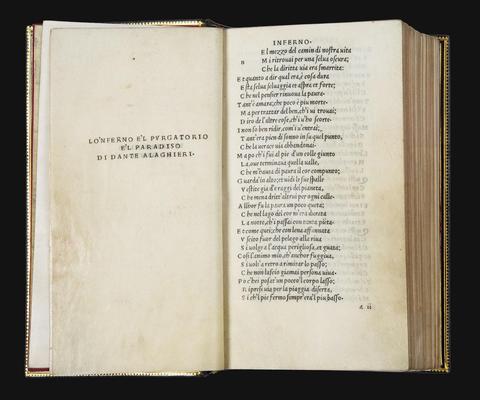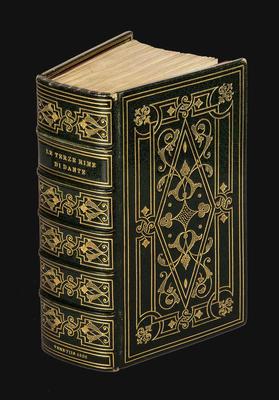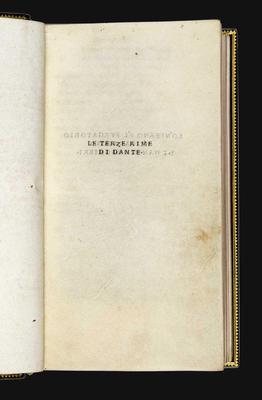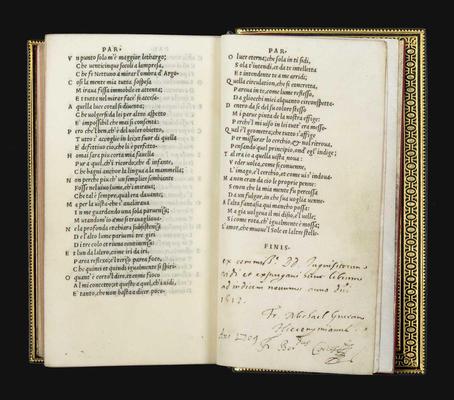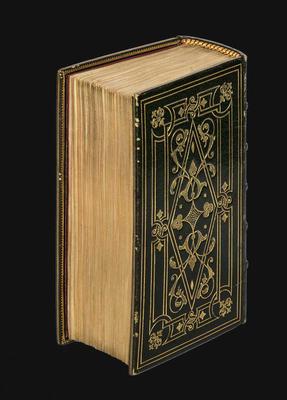Dante Alighieri
Le terze rime di Dante .
[Lyon, Balthazar de Gabiano and Barthélemy Troth, ca.1502-1503].8° (161x90 mm). Printed on vellum. Collation: a-z8, A-F8, G12. [244] leaves, including the blank leaf l2. Italic and roman type. Blank spaces for capitals, with printed guide letters. Green morocco binding dated 1947 and made by Emilio Brugalla. Covers with elaborate gilt tooling, with fillet border enclosing a strapwork lozenge. Spine with five raised bands tooled in gold, title and imprint in gilt lettering. Pastedowns in red silk, flyleaves in red silk and vellum. Board edges with double gold-tooled lines; inside dentelles. Gilt edges. An exceptional wide-margined copy, printed on thick vellum. Two inquisitorial inscriptions on the recto of the last leaf, ‘ex commiß.eDD. Inquisitorum vidi et expurgaui hunc librum ad indicem nouum, anno d.ni1613. Fr Michael Guevara Hieronymianus' and ‘Ano 1709 Fr. Ber.dusCortes'; in line with the Spanish Index of 1612 three short passages in the text have been censored, Inf.,xi7-9 (fol. c8v), Inf.,xix106-117 (fol. f4v), and Par.,ix136-142, (fol. A1v).
Provenance: Andrés Roure Gili (ex-libris on the recto of the front vellum flyleaf); Livio Ambrogio collection.
A sumptuous copy printed on vellum of the Lyonese Dante, one of the rarest Lyon counterfeits of Aldus's octavo italic texts, which appeared only a few months after the original Aldine edition, in spite of his warning against unauthorized reprinting in the colophon of his Commedia. It is the first Commedia printed outside Italy, and perhaps the scarcest sixteenth-century edition of the poem. The volume was issued entirely anonymously and without date, but the printing is attributed to Balthazar de Gabiano from Asti (Piedmont) – according to Baudrier the originator of the Lyonese italic type – and Barthélemy Troth, a dealer working in Lyon for various Italian printers who probably financed the publication. The volume closely copies both the text and the layout of the Aldine Dante, except for the last quire signed ‘G', consisting here of twelve leaves, while in the Aldine it contains eight leaves and is followed by another four-leaf quire.
On the last leaf inquisitorial inscriptions by two Spanish monks dated 1613 and 1709 are visible; in accordance with the Index librorum prohibitorum issued in 1612 by the Grand Inquisitor of Spain Bernardo de Sandoval y Rojas some verses from the Inferno andParadiso have been inked out in this copy, namely, Pope Anastasius' denial of the divine birth of Christ (Infernoxi, 7-9), Dante's criticism of the Donation of Constantine and its consequences (Infernoxix, 106-117), and lastly Folco da Marsigli's denunciation of the corruption of the Church and his ‘prophecy' that the Papacy would return from Avignon in 1305 (Paradisoix, 136-142).
This distinctive feature – together with the excellent condition of the copy, and the bookplate of the great bibliophile from Barcelona Andrés Roure Gili – might suggest that this precious copy of the Commedia on vellum has from very early on always been held in distinguished Spanish private libraries.
Van Praet wrongly lists two copies on vellum of this Lyonese counterfeit, the first preserved at the time in the “Bibliotheque du Roy d'Angleterre”, the second in the “Museum Britannicum”; but at present the only vellum copy of this edition that can be traced is in the Houghton Library of Harvard University (this copy is lacking the blank leaf). William Kemp records the Harvard Dante and suggests that there may be another copy on vellum, hitherto unidentified, elsewhere. Perhaps the present copy?


